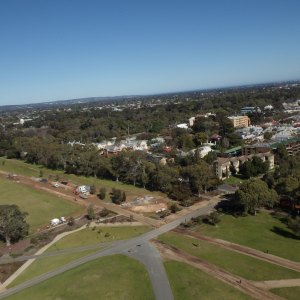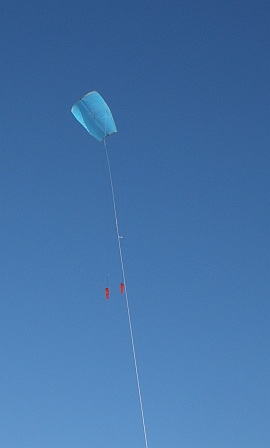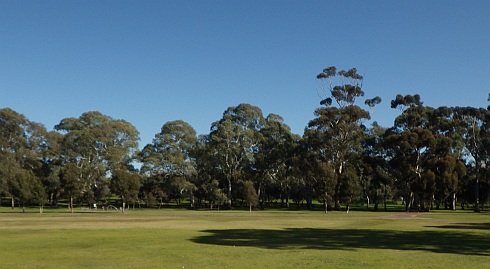- Home Page
- Aerial Photos
- Adelaide CBD
Adelaide CBD (East Parklands)
KAP Report
 Adelaide CBD from the east
Adelaide CBD from the eastA KAP (kite aerial photography) shoot from the eastern parklands of the Adelaide CBD had been on the cards for several weeks. Being the middle of winter, though, the weather had foiled several opportunities. A morning time slot was required, to keep the sun out of the shots.
With
school holidays finished and an unusually blue sky for this time of
year, the city parklands beckoned! Both big sled kites were tossed in
the car, along with the garden-hose reel carrying 200-pound braided
Dacron line. One of the kites would surely suit the breeze.
It
was hoped that some interesting detail of the area around North Terrace
might be captured. However, my camera pointing was a little off. Hence,
the shoot mainly recorded the southern portions of the city square-mile!
Perhaps this was not my very best KAP effort, but these perspectives of Adelaide are rarely seen. So why not publish them.
On this site, there's more kite-making info than you can poke a stick at. :-) Want to know the most convenient way of using it all?
The Big MBK E-book Bundle is a collection of downloads—printable PDF files which provide step-by-step instructions for many kites large and small.
That's every kite in every MBK series.
Weather
A bit of a walk was necessary to get into position. Hence the small but rather heavy yellow chair I use for multi-image panoramas had been left at home. However, one of the first flights recorded several images from just above the grass. One of these images was cropped down a bit to give an indication of the view from the launch point.
An online weather site had shown light winds gusting up 18 kph just before I left for the half-hour trip to the city. Maximum temperature was to be 17 degrees Celsius. In fact, on the return trip (just after midday) the car's outside temperature reading showed 18 degrees—and climbing.
Boisterous gusts whipping across the grass led me to initially try the Fresh Wind Sled. But it turned out to just be the passing of moderately strong thermals. The average wind strength definitely suited the big Multi-Dowel Sled kite, a light-wind design.
A quick check with the wind meter revealed a gust to 17.4 kph. Perhaps gusts were reaching the low 20's higher up. There was certainly plenty of leaf noise in the tall trees of the area.
With no clouds obscuring the sun, the weather was quite consistent the whole time. If anything, the thermal activity got a little stronger as time wore on and the ground heated up further.
The longer patches of grass were still liberally covered in wetness. This felt a bit strange on such a sunny day!
KAP Equipment
 MBK Multi-Dowel Sled
MBK Multi-Dowel SledLifter: The Fresh Wind Sled kite was the first in the air, but it was too difficult to get sufficient height. Big lulls in wind speed kept bringing the kite down. Hence the much larger Multi-Dowel Sled was eventually launched. This kite went straight to the maximum legal altitude!
See my e-book Making Dowel Kites, for more big but cheap kite-designs useful for KAP.
Vertical gusts pulled strong tension into the line, causing it to buzz
at times. The drogues helped keep the kite steady and downwind a little,
so it stayed inflated. Otherwise, there is a small chance it can become a
big "pile of washing" directly overhead—in freefall!
KAP Rig: The trusty bamboo skewer cage with two arms now missing. After a previous KAP session, one arm was broken off accidentally while packing away, so the other was removed also to maintain balance. The half-Picavet suspension line was then transferred to the remaining arms.
Camera: Pentax Optio WG-2 with built-in intervalometer. EV was set to -0.7, which is now my standard for KAP in bright sunlight. For all shots, ISO was on 125, shutter speed 1/1,500th, and focus was fixed on infinity.
Images
These images are samples of what the city of Adelaide looks like from between 200 and 300 feet over the eastern parklands.
Click on the thumbnail images below to see them much larger:
Flight Report
As already mentioned, the Fresh Wind Sled was the first kite up. The reason being that once up high, it might encounter just enough average breeze strength to sustain a long flight. Unfortunately, this did not work out. The camera managed a few shots from just off the grass, but soon both camera and kite were back on the ground.
Most photos were closeups of the green grass as the cradle just
stood on the ground. One image even featured a glorious portrait of my
casual shoes. A fat magpie stood just meters away, poked its beak
skyward and studied the low-flying sled for a moment before deciding to
fly away.
A second attempt was made with the Fresh Wind Sled. This time, at least half the shots were aerial. However, there just wasn't enough wind for the big blue kite. So it was time to put up an even bigger sail. The light-wind Multi-Dowel Sled was fetched and unfurled.
This had turned into a slightly awkward situation. Only the bigger kite would easily launch and gain height in the low average wind-speed. But some of the gusts were quite strong, which would make the huge sled pull like a bull! Still there wasn't any other option if any decent KAP was going to happen.
As expected, getting the bigger kite to full height was easy. At this point the flying line was anchored to a small tree. Also as expected, the kite went very steep and cranked up the tension in the line.
While getting the kite down for a second photo sequence, the carabiner ran hot as I ran it along the line toward the kite. On my way back, with the second photo sequence primed to go off, the line pulled so hard that I felt my weight on the ground decrease momentarily! A short detour let me pick up the Fresh Wind Sled off the grass before taking it back to the tree-trunk tether point. No trees were harmed in the process of doing this KAP shoot. :-)
With the camera dangling around 300 feet up and doing its thing, it was time to grab a few relaxing minutes. It was an opportunity to munch a banana, observe the aerial action, and text my wife to pop outside her office block to try and spot the kite!
Finally, it was time to bring the KAP rig down once again. This done, a few turns of line around a foot enabled me to photograph the still-flying sled a few times. After this, it was just a matter of making sure nothing was left behind on the field before returning home.
The story or stories above document actual flying experiences. My write-ups are definitely "warts and all," since things don't always go totally as planned. However, half the fun of kiting is anticipating the perfect flight. When it happens, it's magic!
As mentioned earlier, there's more kite-making info here than you can poke a stick at. :-)
Want to know the most convenient way of using it all?
The Big MBK E-book Bundle is a collection of downloads—printable PDF files which provide step-by-step instructions for many kites large and small.
That's every kite in every MBK series.





